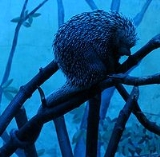
Brazilian Porcupine
Encyclopedia
The Brazilian Porcupine (Coendou prehensilis) is a porcupine
found in Brazil
, Argentina
, Venezuela
, the Guyanas
, Bolivia
and Trinidad
, with a single record from Ecuador
. It inhabits tropical forests at elevations up to 1500 m.
The body is covered with short, thick spines which are whitish or yellowish in color, mixed with the darker hair, while the underside is grayish. The lips and nose are fleshy. The tail is prehensile, with the tip curling upward so as to get a better grip on tree branches. This porcupine can grow to forty inches long, but half of that is tail. It weighs about nine pounds. No spines are found on the tail, which is long (330-485 mm) and prehensile. Its feet are reflective of their arboreal lifestyle, well-adapted for gripping branches, with four long-clawed toes on each.
. Intra-specific interactions consist of biting and attempts to injure adversaries with their sharp quills. When excited, porcupines stamp their hind feet. Vocalizations consist of growls and cries. If caught, the porcupine rolls into a ball. The prehensile tail is used to curl around branches when climbing.
Porcupine
Porcupines are rodents with a coat of sharp spines, or quills, that defend or camouflage them from predators. They are indigenous to the Americas, southern Asia, and Africa. Porcupines are the third largest of the rodents, behind the capybara and the beaver. Most porcupines are about long, with...
found in Brazil
Brazil
Brazil , officially the Federative Republic of Brazil , is the largest country in South America. It is the world's fifth largest country, both by geographical area and by population with over 192 million people...
, Argentina
Argentina
Argentina , officially the Argentine Republic , is the second largest country in South America by land area, after Brazil. It is constituted as a federation of 23 provinces and an autonomous city, Buenos Aires...
, Venezuela
Venezuela
Venezuela , officially called the Bolivarian Republic of Venezuela , is a tropical country on the northern coast of South America. It borders Colombia to the west, Guyana to the east, and Brazil to the south...
, the Guyanas
Guyanas
Guyana is a country in South America.Guyana, Guayana, or Guiana may also refer to:*Guayana Esequiba, the territory of Guyana claimed by Venezuela*Guayana Region, an administrative region of Venezuela...
, Bolivia
Bolivia
Bolivia officially known as Plurinational State of Bolivia , is a landlocked country in central South America. It is the poorest country in South America...
and Trinidad
Trinidad
Trinidad is the larger and more populous of the two major islands and numerous landforms which make up the island nation of Trinidad and Tobago. It is the southernmost island in the Caribbean and lies just off the northeastern coast of Venezuela. With an area of it is also the fifth largest in...
, with a single record from Ecuador
Ecuador
Ecuador , officially the Republic of Ecuador is a representative democratic republic in South America, bordered by Colombia on the north, Peru on the east and south, and by the Pacific Ocean to the west. It is one of only two countries in South America, along with Chile, that do not have a border...
. It inhabits tropical forests at elevations up to 1500 m.
The body is covered with short, thick spines which are whitish or yellowish in color, mixed with the darker hair, while the underside is grayish. The lips and nose are fleshy. The tail is prehensile, with the tip curling upward so as to get a better grip on tree branches. This porcupine can grow to forty inches long, but half of that is tail. It weighs about nine pounds. No spines are found on the tail, which is long (330-485 mm) and prehensile. Its feet are reflective of their arboreal lifestyle, well-adapted for gripping branches, with four long-clawed toes on each.
Behavior
This shy, nocturnal porcupine is solitary or lives in pairs in the branches of trees. During the day it rests in a cavity in a hollow tree or in a well-shaded area of the canopy, 6 to 10 meters above the ground. It rarely descends to the ground, but it shows little fear if it happens to be caught. It is not aggressive but will defend itself ferociously if attacked. Its diet consists of leaves, fruit, and small fresh twigs and shoots. This creature can easily be tamed enough to be kept in captivityCaptivity (animal)
Animals that live under human care are in captivity. Captivity can be used as a generalizing term to describe the keeping of either domesticated animals or wild animals. This may include for example farms, private homes and zoos...
. Intra-specific interactions consist of biting and attempts to injure adversaries with their sharp quills. When excited, porcupines stamp their hind feet. Vocalizations consist of growls and cries. If caught, the porcupine rolls into a ball. The prehensile tail is used to curl around branches when climbing.

